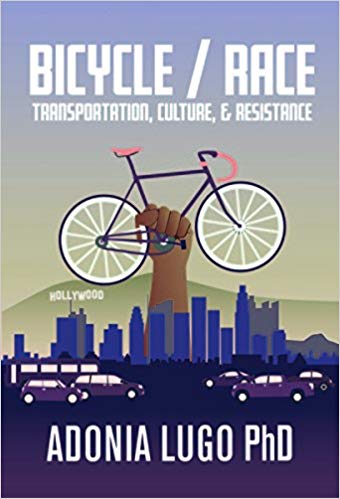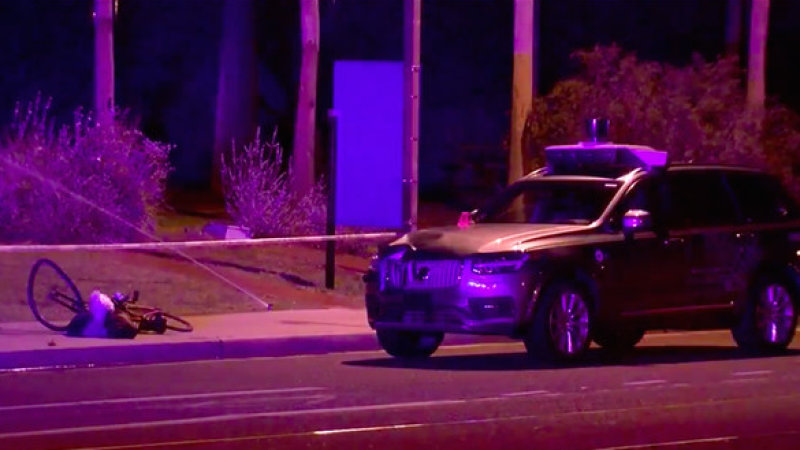 I was enthused to pick up a copy of Adonia Lugo’s latest book at the Bike4Justice event at Rich City Rides. I found it fascinating, though it wasn’t exactly what I had expected. Titled Bicycle/Race: Transportation, Culture, & Resistance, with cover art evoking Black power movements, I anticipated something overtly political, a critical analysis of power dynamics related to cycling in the U.S. Instead, I found the book to be deeply personal to Lugo, a memoir of her own struggles to find a place for herself in cycling advocacy as a mixed-race woman from auto-centric Orange County. Lugo’s academic work is in ethnography, so it is not surprising that she is skilled at illuminating cultural and social frameworks via her lived experiences. As an ardent follower of Lugo’s work, the book helped me understand her perspectives, and how she arrived at her particular brand of advocacy.
I was enthused to pick up a copy of Adonia Lugo’s latest book at the Bike4Justice event at Rich City Rides. I found it fascinating, though it wasn’t exactly what I had expected. Titled Bicycle/Race: Transportation, Culture, & Resistance, with cover art evoking Black power movements, I anticipated something overtly political, a critical analysis of power dynamics related to cycling in the U.S. Instead, I found the book to be deeply personal to Lugo, a memoir of her own struggles to find a place for herself in cycling advocacy as a mixed-race woman from auto-centric Orange County. Lugo’s academic work is in ethnography, so it is not surprising that she is skilled at illuminating cultural and social frameworks via her lived experiences. As an ardent follower of Lugo’s work, the book helped me understand her perspectives, and how she arrived at her particular brand of advocacy.
Lugo’s premise is that cycling advocacy in the U.S., dating back to the founding of the League of American Wheelmen in 1880, is rooted in a culture dominated by white males, and that its manifestation today, which is focused on developing political will for infrastructure development based on Northern European models, marginalizes the interests of other groups. In particular, advocacy neglects to value what she terms as “human infrastructure”; the organizers, social networks, and cycling communities which provide support for riders of all kinds.
Her narrative begins with her PhD research on cycling cultures, continues through her work on creating the CicLAvia open street event, and ends with her decision to leave her position as the Equity Initiative coordinator at the League of American Bicyclists, shortly before her “Unsolicited Advice” post which has been so influential to my thinking. She situates that narrative, though, in her own family’s complex story, a multi-generational legacy of colonialism, segregation and racism. She connects spiritually with the work of feminist poet Gloria Anzaldúa, who writes of inhabiting the borderlands; not only the physical geography of the U.S./Mexico border, but her personal feelings of in-betweenness, as a half-Chicana who speaks Spanish with an American accent, fully at home neither in Mexico nor in San Juan Capistrano.
We can chafe against the borderlands or find comfort within them, but the colonial encounter, its conflicts and affinities, remains alive in our blended blood. We lack the protection that’s supposed to come with living clearly on one side, safe from the real or perceived dangers of the other. The everyday work of maintaining the divide falls to the people who cross boundaries regularly, like the gardeners and the maids and the nannies and the mixed-race, straight-A students like me….
Riding a bike, I’ve felt strong; navigating white supremacy in bike advocacy, I’ve felt powerless. Like many analytical people, I’m of two minds about much of what I’ve seen, and this book reflects the both/and reality I inhabit.
Selected quotes
I found too many important passages to boil down into a blog post, but here are a few which connect with my current work and interests. On what she calls “economic survival” cyclists in Orange County: predominantly Latino men riding to work, often on the sidewalk:
Unlike me, the men on the sidewalk seemed to care more about survival than feeling powerful, respecting the hierarchy of the street rather than trying to disrupt it.
Hierarchy is one of the strongest characteristics of Northern European spatial allocation. User groups and activities are defined and constrained by spatial design. Even shared spaces like woonerfs have implicit spatial hierarchies—with pedestrians at the top, in that case. Copenhagen generally places bikes at the top of the spatial hierarchy, which is why bike advocates love Copenhagen so much. (It’s actually not a great place for pedestrians).
In the U.S., our spatial hierarchy places cars at the top. My thesis is that the project of U.S. bike advocacy, led by privileged whites like me who have internalized cycling as part of their identity, and who found themselves experiencing oppression in our auto-centric hierarchy, has been to upend that hierarchy.
Lugo here is noting that people from different cultural backgrounds may not be interested in upending the spatial hierarchy. Spatial allocation in Latino cultures is much more social, negotiated on an ongoing basis by the users of the space. The hierarchies which emerge are aligned with social hierarchies. Economic survival cyclists are already oppressed by the social hierarchy; they have no interest in challenging the spatial hierarchy. So they’re fine with riding in an informal way, on the bike facility of the sidewalk.
More on this point from Lugo:
[Anthropologists] don’t take it for granted that people are living in accordance with the intentions of planners and designers; instead, we look for the gaps between formal and informal systems…The planning system treats informality primarily as a nuisance, something to be regulated or eliminated.
On being kicked out of the street by L.A. cops while attempting to participate in Park(ing) Day:
I tend to be wary when I hear about [tactical urbanism] because of that day…Street interventions aren’t magic: it’s who is interested in playing in the street that makes street furniture and ‘reclaiming’ space legitimate.
Sahra Sulahmain has done some great writing on Black cultures in South Central LA; how sideshows, turf dancing, tagging, and other cultural expressions do a better job of “activating spaces” than most designer consultants can ever hope to achieve. In Oakland, the Scraper Bike Team (and more broadly, Bike Party) activates space in informal, transgressive ways.
The natural response of the power structure is to attempt to shut down those transgressive uses; Councilmember Noel Gallo is attempting to make participating in a sideshow a felony offense, citing safety concerns. But even though the Ghost Ship tragedy occurred in Gallo’s district, he is not advocating for the criminalization of rave participation. That’s because of who participates in raves (generally affluent whites, including, I’m willing to bet, our current mayor), and who participates in sideshows (generally poor Blacks and Latinos).
Park(ing) Day and DIY Urbanism (as Gordon Douglas writes) are privileged. Oppressed groups are not afforded the same opportunities. The Scraper Bike Team, through years of work, has established themselves well enough in Oakland that they can ride the way they do, within some limits. But Naj K. Smith’s arrest highlights the risks black and brown people take when they attempt to claim urban space.
On the association of cycling with gentrification:
I believed that in order to raise the status of bicycling, we needed to build coalitions with other movements committed to a more just world. We needed to demonstrate how bicycling could be a tool for community resilience. What I heard at Sadik-Khan’s talk was that another way to raise bicycling’s value was to encourage its association with trendy urban design. Once I heard her make that connection, I saw how widespread this project already was.
On Bastille Day I saw this Twitter post by Janette Sadik-Khan, the architect of much of New York City’s revolution in bike infrastructure:
Rue the day: The same Paris street with people on free and equal footing in 1877 has designed people out of the picture today. This Bastille Day, celebrate all streets as living, democratic spaces, not as a still life of cars. pic.twitter.com/UA8HF8Bofk
— Janette Sadik-Khan (@JSadikKhan) July 12, 2019
In Paris Street, Rainy Day, Callebotte is highlighting how the streets have been given over to the bourgeoise. It was painted in 1877, shortly after the completion of the Haussmanization of Paris. Napoleon III had ordered that the working-class districts be demolished; an estimated 120,000 housing units were destroyed. Wide boulevards were constructed to prevent the kind of blockades which had been erected by actual revolutionaries on the actual Bastille Day.
So Sadik-Khan is referring to a literally bougie Paris, which had been created by an actual emperor, as a “living, democratic space.” And this isn’t just historical cluelessness; Sadik-Khan’s philosophy, same as Hausmann’s, is to transform the city to make it a better location for bougie commerce.
On her inability to affect the League of American Bicyclist’s adoption of Vision Zero:
I was being asked to equity-wash this new silver bullet that fit the same old mold: Northern European origins, pushed through via political capital rather than grassroots organizing, emergent from within the closed networks of advocacy organizations.
I have personally become increasingly uncomfortable with the tactics mainstream bike advocacy is using to develop political capital, particularly the amplification of safety risks, and the equation of cycling infrastructure with economic development. And the use of those tools does not appear to be abating.
Conclusion
Bicycle/Race reads as a memoir. It provided me with greater insight into the personal experiences which led her to a critical and somewhat cynical view of U.S. bike advocacy. The book itself is not a critical analysis; readers not already aligned with Lugo’s perspective will probably not find its arguments compelling. But for someone like me who admires her work, it provides a rich personal narrative to pair with the other critical and academic work she has done, in support of a more inclusive and human bike advocacy.


